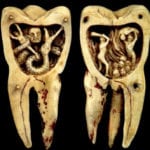 Weird Stuff
Weird Stuff  Weird Stuff
Weird Stuff  Our World
Our World 10 Ways Your Christmas Tree Is More Lit Than You Think
 Movies and TV
Movies and TV The 10 Coolest Stars to Set Sail on The Love Boat
 History
History 10 Things You Didn’t Know About the American National Anthem
 Technology
Technology Top 10 Everyday Tech Buzzwords That Hide a Darker Past
 Humans
Humans 10 Everyday Human Behaviors That Are Actually Survival Instincts
 Animals
Animals 10 Animals That Humiliated and Harmed Historical Leaders
 History
History 10 Most Influential Protests in Modern History
 Creepy
Creepy 10 More Representations of Death from Myth, Legend, and Folktale
 Technology
Technology 10 Scientific Breakthroughs of 2025 That’ll Change Everything
 Weird Stuff
Weird Stuff Ten Bizarre Facts About The Doge Meme
 Our World
Our World 10 Ways Your Christmas Tree Is More Lit Than You Think
 Movies and TV
Movies and TV The 10 Coolest Stars to Set Sail on The Love Boat
Who's Behind Listverse?

Jamie Frater
Head Editor
Jamie founded Listverse due to an insatiable desire to share fascinating, obscure, and bizarre facts. He has been a guest speaker on numerous national radio and television stations and is a five time published author.
More About Us History
History 10 Things You Didn’t Know About the American National Anthem
 Technology
Technology Top 10 Everyday Tech Buzzwords That Hide a Darker Past
 Humans
Humans 10 Everyday Human Behaviors That Are Actually Survival Instincts
 Animals
Animals 10 Animals That Humiliated and Harmed Historical Leaders
 History
History 10 Most Influential Protests in Modern History
 Creepy
Creepy 10 More Representations of Death from Myth, Legend, and Folktale
 Technology
Technology 10 Scientific Breakthroughs of 2025 That’ll Change Everything
10 Props That Were Repurposed for Another Film
It’s not called “show fun”; it’s called “show business.” Movies are made to make money. It doesn’t matter if you’re Michael Bay, churning out explosion porn year after year, or Charlie Kaufman, making convoluted meta-narratives about yourself making movies; every director has to eat.
Producers find ways to cut costs that help to increase the bottom line. A big part of that is recycling props, and if you look closely enough, you’ll see that almost every film and show in history borrows and lends its props over and over again. Some are placed in movies intentionally by directors as easter eggs or hints at shared universes, while some are put on screen out of sheer laziness. Either way, there are a lot of props that have made the rounds through cinema history, and here are ten of the most fun and interesting examples.
Related: 10 Famous Props And The Actors Who Stole Them
10 Robby the Robot
To truly understand the unique story of Robby the Robot, let’s compare his story to another famous big-screen bot: R2-D2. Like Artoo, Robby was introduced as a unique character in his own movie; instead of Star Wars, it was the ground-breaking 1956 sci-fi classic Forbidden Planet. Like Artoo, Robby was a real character with a name, dialogue, and personality. But unlike Artoo, Robby’s creators weren’t Lucas-level litigious, so Robby outlived his original franchise by decades.
After Forbidden Planet, the Robby the Robot suit was left in the props department at MGM Studios, and dozens of other shows and movies took advantage of the free droid. Robby, usually credited as some variation of “The Robot,” was in multiple Twilight Zones. He battled the family robot on Lost in Space. He befriended Mork from Ork on Mork and Mindy. He was in Wonder Woman, Gremlins, and even the Addams Family. Now try and imagine Artoo freely given to all those projects instead.
9 Mr. Fusion
The Mr. Fusion Home Energy Reactor first appeared in Back to the Future. It replaced plutonium as the DeLorean’s main power source, as it was better for the environment and attracted fewer Libyan terrorists. Using ordinary household garbage, the marvelous Mr. Fusion could generate cold fusion energy, a full 1.21 gigawatts worth. Its usefulness didn’t stop at flying cars, though; it also helped power the spaceship Nostromo from Alien.
In several scenes in Alien, the Mr. Fusion can be seen hanging on the wall in the crew’s mess hall right above the coffee maker. While Ripley and the company fuel themselves, Doc Brown’s garbage machine fuels their ship. That, or the prop team from Back to the Future just picked the first sci-fi-looking thing they could find from a Hollywood warehouse.
8 Those Glowy Sci-Fi Tubes
Chances are, if you’ve seen a single major sci-fi film, you’ve seen this prop. It goes by many names, such as “blinking tubes without function” and “dual generators with rotating neon lights inside an acrylic tube,” but you’ll know it best by its appearance: a pair of glowing red future tubes. It is absolutely everywhere. Its earliest known appearance is in Star Trek II: Wrath of Khan, and from there, it proceeded to…do whatever it does…on nearly every ship in the multiverse.
It’s been in The Last Starfighter, Star Crystal, nearly every incarnation of Star Trek, and even superhero works like The Flash, Lois & Clark, and The Incredible Hulk Returns. It’s no surprise, then, that the online community has taken to calling it “The Most Important Device in the Universe.”
7 Okay, Actually All the Sci-Fi Equipment
The Most Important Device may have competition. Have you ever noticed that the background of every spaceship, research lab, and secret government base is always filled with wall-to-wall giant computers with big, blinking lights? It’s hard to conjure up an image of any famous sci-fi facility without them. They’re actually all a real, or at least replicating a real, computer: the AN/FSQ-7 Combat Direction Central, nicknamed the Q7.
Developed by IBM for the military in the 1950s, the Q7 was at the time the largest standalone computer ever built, spanning entire rooms and weighing a whopping 250 tons. But mainly, it looked cool—specifically its maintenance console. The consoles, or reproductions, have become the default sci-fi and espionage computers in cinema for sixty years, in films and television as diverse as Independence Day, Lost, Gremlins II, Goldmember, Logan’s Run, and WarGames. Google “AN/FSQ-7 maintenance console,” and the search results page will look like the bridge of a Star Destroyer.
6 Let’s/Heisler/Morley
You probably ignore the generic brand labels on the food and drink that movie and TV characters eat. That’s good; producers don’t want you to. Instead of creating new props for every film, producers love reaching into the same standby bag of tricks and pulling out the same few brands movie after movie. That’s why Let’s Chips, Heisler Beer, and Morley Cigarettes each have filmographies that would make Sam Jackson blush.
There is a specific wiki for fictional businesses, and a visit to the page for any of these faux products will elicit a gasp. They’ve been everywhere. Heisler edges out the others in the sheer number of appearances; after all, you’ll find more scenes are built around characters having a beer than splitting a cig these days. Let’s, however, have to be the most famous. Community, in its typical meta style, made Let’s Chips a running gag on the show, often comparing them to “that other greasy brand,” Splingles.
5 Red Apple Cigarettes
Speaking of cigarettes, one of the most famously reused props in cinema history has to be Red Apple Cigarettes, the brand featured in almost every movie Tarantino has released. Unlike most of the entries on this list that were reused to save money, Red Apples are deliberately placed by Tarantino in his movies, denying Morley a handful of precious film credits.
There are a few theories as to why these cigarettes appear so frequently. Many cite Tarantino’s desire to place all of his movies in the same universe; it is true that many already are. Another theory is based on the director’s love for symbolism, positing that the logo of a hideous worm emerging from an otherwise pristine apple is meant to hint at the ugliness within even the most beautiful things. It is also possible that Tarantino’s just having fun.
4 The Starship Troopers
Starship Troopers produced a lot of iconic imagery, including the classic slate grey space-marine armor worn by the titular soldiers. Nearly every main character wears the armor in the film, and most do so for the majority of their screen time. It’s even featured prominently on the home media covers. That’s why it’s weird that dozens of the suits would show up, barely modified at all, in the completely unconnected show Firefly.
The main antagonist of the Firefly series (rest in peace) was the galactic government known as the Alliance. Throughout the show, we see Alliance soldiers more than most characters, and they’re always clad in Starship Trooper armor, just default-issue Mobile Infantry armor from head to toe. It’s unmistakable and a bit jarring for fans of both franchises.
3 That Same Dang Newspaper
There are few props more inconspicuous than a simple newspaper. Who would pay attention to filler text in the background of a routine breakfast scene? Yet one newspaper has appeared in such an insane amount of movies; it’s starting to draw focus.
This prop paper has been around since the ’60s, with a blank front that allows for custom headlines but always the same two middle pages; it’s always open to the middle pages. Photos of a dark-haired woman, a man in a top hat, and warehouse burning jump out at you, as seemingly every character in every show and movie in history is always reading about them. Once you first spot this paper, usually the woman’s headshot, you’ll notice it for the rest of your life; it doesn’t make much sense to engineer an entirely new paper, after all.
2 The P.K.E. Meter
This entry ranks higher than most because the P.K.E. meter from Ghostbusters is a pretty central piece of hardware to the movie. In both films, the ‘Busters use it to detect the presence of ghosts. For a Ghostbuster, that’s kind of a big deal. Its appearance also demands attention, with extendable wings and rows of blinking lights. It’s odd, then, that John Carpenter decided to reuse the meter as an alien-detector in They Live.
Such a specific and literally flashy prop is hard to miss, which is why it’s even odder that it makes another appearance in the tragic accident that was Suburban Commando. Imagine, for example, if the proton packs had appeared in Twins or the ghost trap showed up in The ’Burbs.
1 Gwyneth Paltrow’s Head
It’d be a safe bet to say that the most famous movie prop in history that we never actually see is the contents of the briefcase in Pulp Fiction. If there’s a clear runner-up, I’d argue that it’s the contents of the box from Seven. Spoiler: the box contains the severed head of Gwyneth Paltrow’s character, though we never get to see it. A prop head was made for the scene, however. An eerily lifelike reproduction of Paltrow’s head was made but cut from the ending of the movie. Then the bespoke severed head sat in a storage vault for 16 years until it finally found use.
In Contagion, Paltrow’s character again dies, this time from a deadly virus. When it came time to film the autopsy of her body, producers were able to save a few tens of thousands of dollars and give Paltrow the day off. Instead, they dusted off the old severed head from Seven and placed it atop a dummy. That makes the head somewhat unique in that it only makes one film appearance and yet is absolutely a major reused prop.








